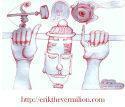Be Kind! Share with your Team, with your Family, with your Buddies!
Click The Button Now & Like This On Your Facebook Page!
Saturday, June 01, 2013
What Makes The Anaerobic Adhesive Curing Mechanism Unique?
In most purposes a liquid is utilized. The viscosity will differ between the varying types of anaerobic glues, some will be much more like a gel which will adhere to the metal and some will be so thin they will wick or seep into tight areas.
What makes these kinds of adhesives distinctive is their ability to cure. In the absence of air, and in the presence of metal ions the curing process begins. Powerful polymer chains are shaped that develop a tenacious bond in between metals. As opposed to conventional glues that cure by means of largely evaporation through the air, the air impedes anaerobic adhesives.
Though anaerobic purposes differ extensively, in many cases the adhesive provides higher shear strength and exhibits very little flexing or peel forces. When anaerobic products are utilized to lock threaded assemblies together, they prevent loosening and corrosion of the assembly. As an example, when an anaerobic adhesive is sealed in between a nut and a bolt on a threaded assembly, it rapidly cures to form a tough, crosslinked plastic with strong adhesion to many metals.
As the liquid threadlocker cures, it finds its way into each small imperfection within the threads. The adhesive completely fills the microscopic gaps in between interfacing threads to lock and seal the assemblies, preventing lateral movement and corrosion that can result from moisture, gases, and fluids.
The sealing character of anaerobic glue makes it ideal for use as formed-in-place gaskets that provide a seal in between flange faces. Since they allow you to create joints with a line-to-line fit in between metal flanges, they remove the need for tightly controlled flange surface finishes and the problems related with compression gaskets, including compression set, bolt relaxation, and loosening.
For rigid, cylindrical assemblies, including joining a bushing to a shaft, anaerobic adhesives have replaced press fits and shrink fits in many assemblies. Press and shrink fits typically call for tight manufacturing tolerances and costly surface finish requirements. Because they typically require cumbersome heating and cooling of components before assembly, the assembly can actually be distorted.
In manufacturing operations in which application of a liquid threadlocker is not desirable, industrial adhesive manufacturers have created pre-applied dry threadlockers that cure once the threaded device is assembled.
Through adhesive technology new glues are being created and conventional types being enhanced, but perhaps this sort of adhesive, anaerobic, will always have the most interesting curing mechanism.
For more information about Adhesive System's structural adhesives or any other adhesives please contact us at 877.740.1250 x20. You can also send us an email at asisupport@instantca.com. If you don't find exactly what you're looking for, tell us about your application and we'll help you find something that will work, or customize something specific for you.















